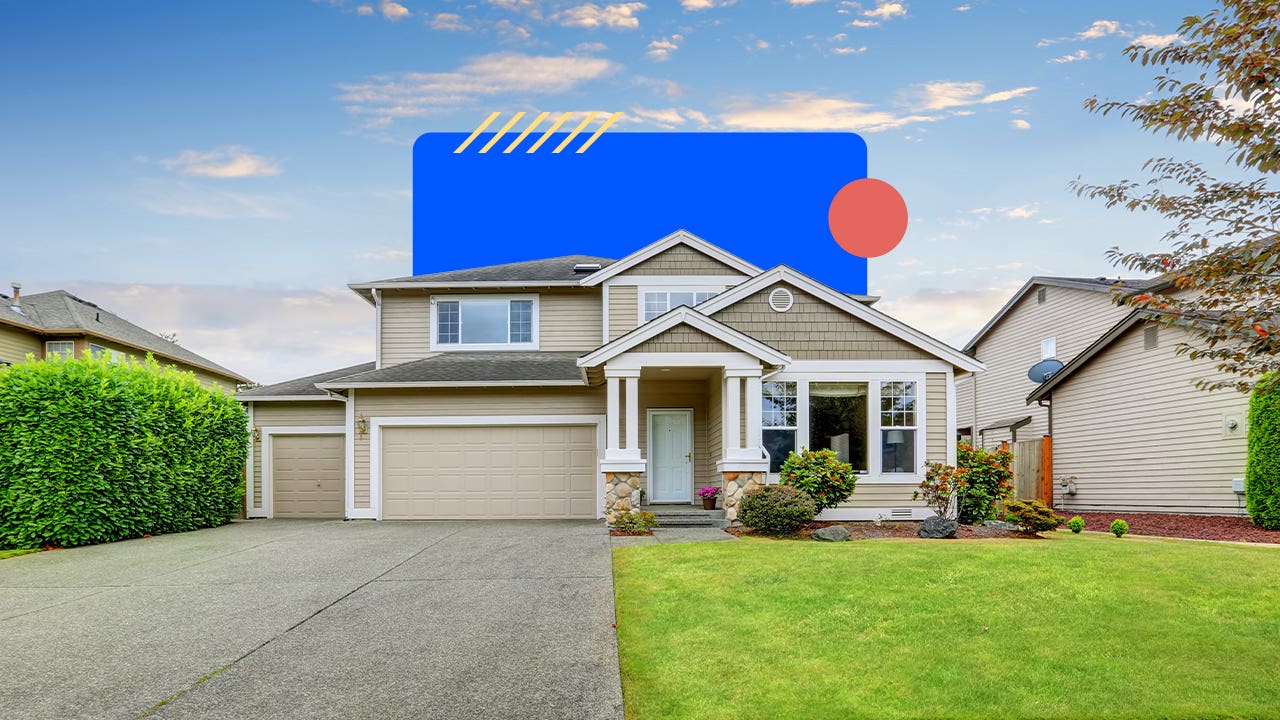Private mortgage insurance (PMI): What it is and how it works

The Bankrate promise
At Bankrate we strive to help you make smarter financial decisions. While we adhere to strict , this post may contain references to products from our partners. Here's an explanation for .
Key takeaways
- Private mortgage insurance (PMI) is an extra monthly fee that you pay on a conventional mortgage if you put less than 20 percent down.
- PMI must be terminated at a certain point in your loan term or when your mortgage balance drops to a certain percentage of your home’s worth.
- The amount you pay in PMI depends on your loan and down payment size, whether it's a fixed- or adjustable-rate mortgage and your credit score.
What is private mortgage insurance (PMI)?
Private mortgage insurance (PMI) is an extra expense that conventional mortgage holders have to pay lenders each month. It typically applies to borrowers whose down payment on a home is less than 20 percent of the purchase price. Although the borrower is paying for it, PMI actually protects the lender. It compensates them for the extra risk they’re assuming by extending a larger loan, and demanding less cash upfront from you.
However, you won’t pay PMI forever. According to the Consumer Finance Protection Bureau, lenders must cancel it on the date your mortgage balance drops to 78 percent of your home’s original value (its worth when you bought it), or when you are halfway through your loan term.
Even before this scheduled date, once you pay down your mortgage balance to 80 percent of your home’s original value, you can request your lender to remove your PMI. Also, if your home’s value has grown to the point where you’d now have 20 percent equity, you can request PMI removal. However, you’ll likely have to pay for an appraisal to confirm the home’s worth.
Is PMI required for all types of mortgage loans?
PMI is not required in all cases. It is needed when you get a conventional mortgage with a down payment of less than 20 percent. FHA loans have their own type of mortgage insurance premiums that you’ll pay upfront and annually. VA loans don’t require PMI or any other type of mortgage insurance.
PMI vs. MIP vs. MPI
- PMI
- PMI is a type of insurance that protects the lender should you default on your mortgage. It applies when you make a down payment under 20 percent.
- MIP
- A mortgage insurance premium (MIP), is a type of mortgage insurance that comes with a Federal Housing Administration (FHA) insured mortgage. This includes an upfront premium, typically paid at closing, as well as annual premiums.
- MPI
- This is a type of life insurance that pays off your mortgage when you die or become disabled.
How much does PMI cost?
The average monthly cost of PMI is 0.46 percent to 1.5 percent of the loan amount, according to an analysis by the Urban Institute.
Here’s a look at how PMI might play out based on how much you put down, according to the Freddie Mac mortgage insurance calculator and the Bankrate mortgage calculator. These examples assume a $410,000 home purchase price and a 7.96 percent interest rate.
| Down payment | 5% down | 10% down | 15% down | 20% down |
|---|---|---|---|---|
| Note: The total monthly mortgage payments in this table don’t include homeowners insurance, HOA fees or property taxes. | ||||
| Monthly PMI payment | $374 | $240 | $98 | $0 |
| Monthly mortgage payment | $2,847 | $2,697 | $2,547 | $2,398 |
| Total monthly mortgage payment | $3,221 | $2,937 | $2,645 | $2,398 |
Factors that influence the cost of PMI
- Your loan-to-value (LTV) ratio: The LTV ratio measures the percentage of the home’s purchase price you’re financing against the value of the home. The higher your LTV ratio, the higher your PMI payment.
- Your credit score: Your credit history and corresponding credit score play a major role in the cost of PMI. For example (using the Urban Institute figures), say someone is buying a $300,000 property with a 3.5 percent down payment. With an excellent FICO score of 760 or greater, the monthly mortgage payment including PMI is $2,018. For a buyer with a mediocre credit score between 620 and 640, those monthly payments are $2,269 — a reflection of a significantly higher PMI charge.
- Your loan type: Because adjustable-rate mortgages (ARMs) carry a higher risk for lenders, your PMI might be more expensive with an ARM than it might be with a fixed-rate mortgage loan.
- Your down payment amount: A down payment of 20 percent or more results in no PMI. Below that cut-off, there can be a significant difference in the amount you’ll pay every month, depending on how much money you put down. The closer your down payment is to 20 percent, the less your PMI.
PMI example
Say you make a 10 percent down payment on a $410,000 home. That equals $41,000. You’ll get a 30-year fixed-rate mortgage at 7.96 percent to pay the remaining $369,000 of the home’s purchase price. Because your down payment isn’t 20 percent, you’ll pay mortgage insurance premiums, but only until you pay down your loan balance to 80 percent, or $328,000. If you follow the repayment schedule, you’ll hit this mark a little over nine years into the loan.
Types of private mortgage insurance
-
Borrower-paid PMI is what people generally mean when they refer to mortgage insurance. With borrower-paid PMI, the premiums are part of your monthly mortgage payment. You’ll be able to stop paying them once you reach 20 percent equity in your home — if you request cancellation — or automatically when your mortgage balance reaches 78 percent of your home’s value.
-
Lender-paid mortgage insurance might sound appealing, but make no mistake: You’ll still pay for the coverage. Instead of seeing that premium as a line item on your mortgage statement, you’ll pay a higher interest rate on the loan. You can’t get lender-paid PMI canceled in the same way that you can with borrower-paid insurance, either. The main path to getting out of lender-paid PMI is to refinance.
-
Instead of dividing up payments into regular installments each month, single-premium PMI bundles the entire cost of the premiums into one lump payment. Depending on the terms of the loan, you can either pay this in full at closing or roll the amount into the loan for a higher balance. If you pay it upfront, you’ll get the benefit of lower monthly mortgage payments. You might not have the funds to make this happen, however. Plus, if you sell your home before you would have stopped paying PMI, you might wind up worse off. In that case, you paid premiums in advance for nothing.
-
In a split-premium PMI arrangement, you’ll pay a larger upfront fee that covers part of the overall insurance costs; you’ll pay the remainder with your monthly payments. This strategy combines the pros and cons of single-premium and borrower-paid PMI. You need some cash, but not as much, to pay the upfront premium, and your monthly payments won’t be as high. Split-premium mortgage insurance can also be helpful if you have a debt-to-income (DTI) ratio that’s on the high side. It allows you to lower your potential mortgage payment to avoid pushing your DTI too high to qualify for the loan.
Should you pay PMI?
Paying PMI comes with one major benefit: It enables you to buy a home without waiting until you can afford a 20 percent down payment. Home prices remain high, at a median of $384,500 nationally as of Feb. 2024, according to the National Association of Realtors.
Homeownership is generally an effective long-term and generational wealth-building tool. Buying a property sooner rather than later allows you to acquire an important asset and start building equity. If home prices in your area rise at a percentage that’s higher than what you’re paying for PMI, then your monthly premiums — costly as they are — are actually helping you net a positive return.
The typical U.S. home sells for close to $400,000, and coming up with a 20 percent down payment means writing a check for $80,000. Many first-time buyers don’t have that much money. So even though paying private mortgage insurance isn’t anyone’s favorite thing to do, the upside is that PMI lets buyers get into a challenging housing market even if they haven’t amassed a stash of cash.— Jeff Ostrowski, Principal Writer, Bankrate
How to avoid paying PMI
In some cases, it is possible to avoid paying private mortgage insurance. Here are some of the ways to do it:
- Put 20 percent down: If you put 20 percent down on a home, you’ll avoid the PMI expense altogether. That can be tough to save up for, however (though down payment assistance might help).
- See if your lender offers piggyback loans: A piggyback loan, also known as an 80/10/10 or combination mortgage, takes the form of two loans: one for 80 percent of the home’s price, the other for 10 percent of the home’s price. You’ll then pay 10 percent as a down payment. The upside: You won’t pay PMI. The downside: The two loans could end up costing more than PMI in interest and closing costs.
- Get a VA loan: Mortgages guaranteed by the Department of Veterans Affairs (VA) don’t require PMI. If you’re a military veteran, active-duty service member or surviving spouse, you might qualify for a VA loan, which doesn’t require a down payment or PMI. (You’ll need to pay a funding fee, however.)
How to get rid of PMI
There are a few ways to get rid of PMI:
- Wait until it’s automatically canceled: Federal law dictates that your mortgage lender must automatically end your PMI once you are one month past your term’s midpoint, or when your LTV ratio drops to 78 percent. In other words, you’ll stop paying PMI when you have 22 percent equity in your home.
- Request PMI cancellation: Federal law also allows you to request that PMI be canceled when you have 20 percent equity in your home. You must submit your request in writing to your lender or loan servicer, and you might need to get an appraisal.
- Have your home reappraised: With recent rises in home prices, you may have 20 percent equity in your home, even if you haven’t owned it long. To prove this, you’ll need to get your home reappraised.
Private mortgage insurance FAQ
-
There are three main ways to make PMI payments. Your options may vary depending on your lender:
- Monthly: The most common method is paying PMI premiums monthly with your mortgage payment. This boosts the size of your monthly bill but allows you to spread out the premiums over the year.
- Upfront: Another option is an upfront PMI payment, meaning you pay the full premium amount for the year all at once. Your monthly mortgage payment will be lower, but you need to be ready for that larger annual expense. Also, if you move sometime in the year, you might not be able to get part of your PMI refunded.
- Hybrid: The third option is a hybrid one: paying some upfront and some each month. This can be useful if you have extra cash early in the year and want to lower your monthly housing costs.
-
Virtually every lender requires PMI for conventional mortgages with a down payment less than 20 percent. Some lenders advertise “no-PMI” loans, but these are essentially lender-paid insurance arrangements — you’ll likely pay a higher interest rate in exchange.
-
You’ll pay PMI until you’ve reached 20 percent equity in your home, or an 80 percent loan-to-value (LTV) ratio on your mortgage. Loan servicers must cancel PMI once you reach a 78 percent LTV ratio, based on the home’s original appraised value, or halfway through your loan’s term (15 years into a 30-year mortgage, for example).
-
PMI was tax-deductible through the 2021 tax year. It expired for the 2022 tax year and has not been renewed for subsequent years.
-
Mortgage insurance protects your lender in the event you don’t pay back your mortgage. Homeowners insurance protects you and your home in case something happens to it. Lenders require mortgage insurance if you’re getting a conventional loan and putting less than 20 percent down; they also require homeowners insurance for any type of mortgage.
Related Articles



